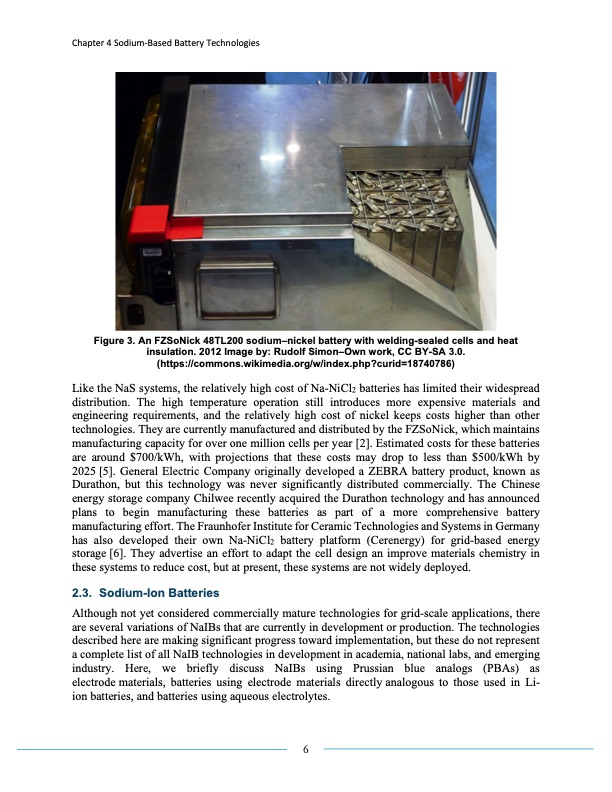
PDF Publication Title:
Text from PDF Page: 006
Chapter 4 Sodium-Based Battery Technologies Figure 3. An FZSoNick 48TL200 sodium–nickel battery with welding-sealed cells and heat insulation. 2012 Image by: Rudolf Simon‒Own work, CC BY-SA 3.0. (https://commons.wikimedia.org/w/index.php?curid=18740786) Like the NaS systems, the relatively high cost of Na-NiCl2 batteries has limited their widespread distribution. The high temperature operation still introduces more expensive materials and engineering requirements, and the relatively high cost of nickel keeps costs higher than other technologies. They are currently manufactured and distributed by the FZSoNick, which maintains manufacturing capacity for over one million cells per year [2]. Estimated costs for these batteries are around $700/kWh, with projections that these costs may drop to less than $500/kWh by 2025 [5]. General Electric Company originally developed a ZEBRA battery product, known as Durathon, but this technology was never significantly distributed commercially. The Chinese energy storage company Chilwee recently acquired the Durathon technology and has announced plans to begin manufacturing these batteries as part of a more comprehensive battery manufacturing effort. The Fraunhofer Institute for Ceramic Technologies and Systems in Germany has also developed their own Na-NiCl2 battery platform (Cerenergy) for grid-based energy storage [6]. They advertise an effort to adapt the cell design an improve materials chemistry in these systems to reduce cost, but at present, these systems are not widely deployed. 2.3. Sodium-Ion Batteries Although not yet considered commercially mature technologies for grid-scale applications, there are several variations of NaIBs that are currently in development or production. The technologies described here are making significant progress toward implementation, but these do not represent a complete list of all NaIB technologies in development in academia, national labs, and emerging industry. Here, we briefly discuss NaIBs using Prussian blue analogs (PBAs) as electrode materials, batteries using electrode materials directly analogous to those used in Li- ion batteries, and batteries using aqueous electrolytes. 6PDF Image | SODIUM-BASED BATTERY TECHNOLOGIES CH 4

PDF Search Title:
SODIUM-BASED BATTERY TECHNOLOGIES CH 4Original File Name Searched:
ESHB_Ch4_Sodium_Spoerke-1.pdfDIY PDF Search: Google It | Yahoo | Bing
Salgenx Redox Flow Battery Technology: Salt water flow battery technology with low cost and great energy density that can be used for power storage and thermal storage. Let us de-risk your production using our license. Our aqueous flow battery is less cost than Tesla Megapack and available faster. Redox flow battery. No membrane needed like with Vanadium, or Bromine. Salgenx flow battery
| CONTACT TEL: 608-238-6001 Email: greg@salgenx.com | RSS | AMP |